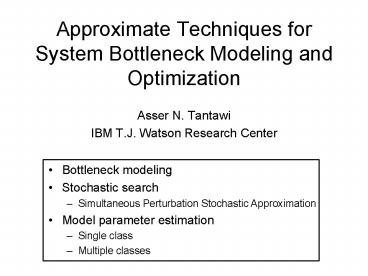Approximate Techniques for System Bottleneck Modeling and Optimization - PowerPoint PPT Presentation
1 / 16
Title:
Approximate Techniques for System Bottleneck Modeling and Optimization
Description:
Robbins-Monro Stochastic Approximation (RMSA) Based on noisy measurements Y() of ... Estimate parameters using stochastic search. SPSA is a viable search method ... – PowerPoint PPT presentation
Number of Views:148
Avg rating:3.0/5.0
Title: Approximate Techniques for System Bottleneck Modeling and Optimization
1
Approximate Techniques for System Bottleneck
Modeling and Optimization
- Asser N. Tantawi
- IBM T.J. Watson Research Center
- Bottleneck modeling
- Stochastic search
- Simultaneous Perturbation Stochastic
Approximation - Model parameter estimation
- Single class
- Multiple classes
2
IBM Websphere Extended Deployment
3
All models are wrong Some are useful. George
E.P. Box
Everything should be made as simple as possible,
but not simpler. Albert Einstein
Multi-Tier Internet Applications
Too simple!
Too complex!
4
Theorem (AviItzhak, Friedman 1965) In a
sequence of n singleserver stations with an
arbitrary arrival process, constant service times
at all servers, and FIFO discipline, the time
spent in the system by each job is independent of
the order of the stations. Moreover, this time is
equal to the sum of the service times plus the
time that the same job would wait in a queue at a
singlestation system with the station of the
longest service and the same arrival process.
Tandem queues
S S1 S2 S3 X1 maxS1, S2, S3 X2 S X1
X2
X1
Equivalent model
5
S1 1 S2 3 S3 2 Exponential service time Z
10
Actual Tandem queues Model Equivalent model
6
Multiserver Queue Approximation An M-server
queue with service time S may be approximated by
a sequence of a singleserver queue with service
time S/M and a delay queue with service time (S
S/M).
Parallel servers
X1 S / M X2 S X1
X2
X1
Approximate model
7
M 4 S 1 Z 2
Actual M-server queue Model Equivalent 1-server
model
8
(No Transcript)
9
(No Transcript)
10
Stochastic Optimization Problem
that solves
Find
where
- L is not known, but observable
- (system, simulation, model, numerical, )
- L is measurable, but noisy
11
Robbins-Monro Stochastic Approximation (RMSA)
Based on noisy measurements Y() of gradient g()
k0,1,
positive gain sequence
necessary for convergence
and
asymptotically cancel the noise effects
e.g.
agt0
For
12
Gradient Approximations Based on Function
Measurements
Finite Difference (FDSA)
i th component, i1, 2, , p
Kiefer-Wolfowitz
positive sequence
Simultaneous Perturbation (SPSA)
Random search
y(.)L(.)noise
13
1. Collect system (black box) measurements
S1 1 S2 3 S3 2 Z 2
Z
S1
S2
S3
rhoB
N
2. Given N and T, estimate X1 and X2
Using stochastic approximation technique X1
3.17 X2 5.09 Error 0.31
Error T T /sqrt(T)
14
1. Collect system (black box) measurements
40.0 40.0 5.0
1.0
2.0
3.0 5.0 2.0
3.0
1.5
2.0
rhoB
N
2. Given N and T, estimate X1 and X2
Error 4.33
15
(No Transcript)
16
SPSAConvergence
Summary
- Model multi-tier system as a multi-class machine
repairman model - Estimate parameters using stochastic search
- SPSA is a viable search method
- Efficient multi-class model solution































